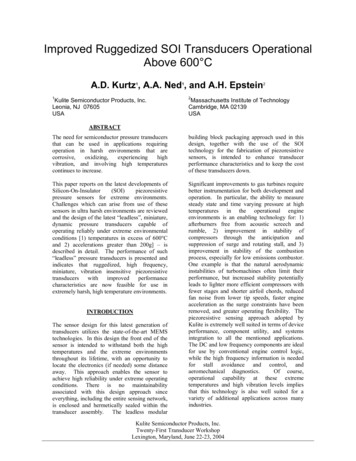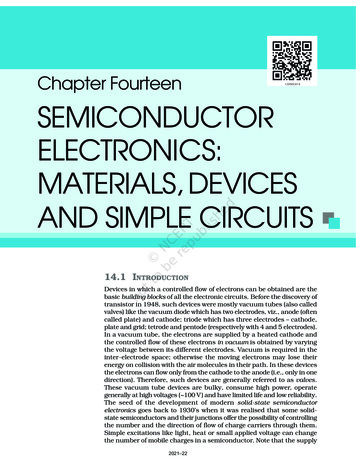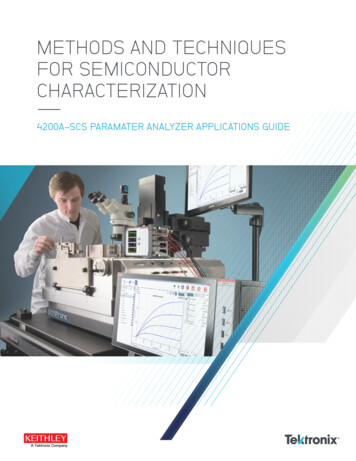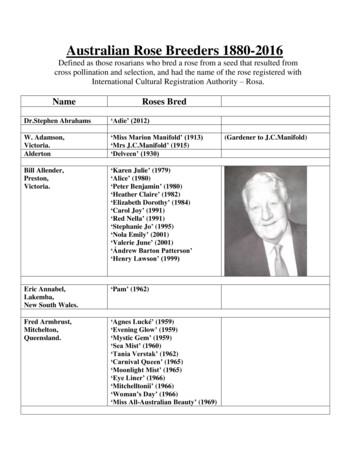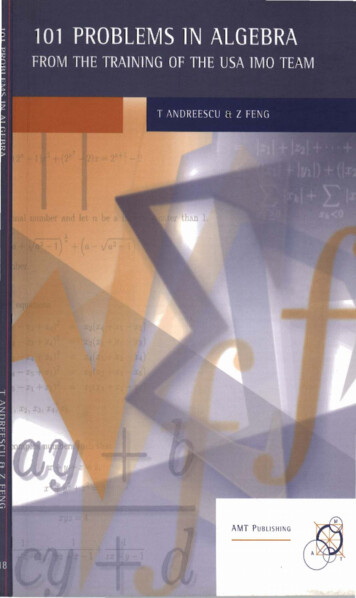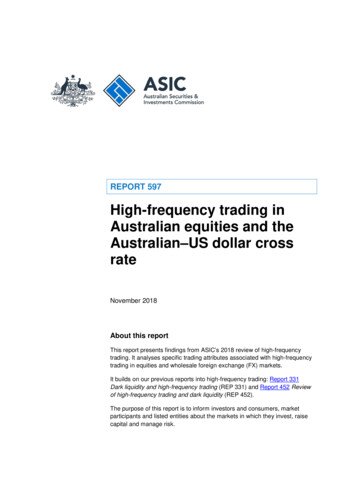Transcription
Australian Semiconductor Sector studyCapabilities, opportunities and challenges for increasing NSW’sparticipation in the global semiconductor value chainDecember 2020This report has been prepared for the Office of the NSW Chief Scientist & Engineerby the University of Sydney Nano Institutei
DisclaimerThird Party RelianceThis report is solely for the purpose set out in the Executive Summary and for the NSWGovernment’s information. It has been prepared as a summary of more extensive data andinformation collection, analysis and synthesis, interim reports, observations and findings for aspecific NSW Government purpose which may not relate to any single reader’s specificsituation.The NSW Government does not take responsibility arising in any way from reliance placedby a third party on this report. Any reliance placed is that party’s sole responsibility. We shallnot be liable for any losses, claims, expenses, actions, demands, damages, liability or anyother proceedings arising out of reliance by any third party on this endent-reportsii
ForewordThe Sydney Nano Institute undertook this scoping study on behalf of the Office of the NSWChief Scientist & Engineer. Our aim was to provide an independent, industry-focusedperspective on the current state and demand for semiconductor capability in Australia, and tosuggest opportunities for future growth. Semiconductors are the key component in the mostadvanced electronic systems and will underpin development of emerging technologies for along time to come. We would like to thank the more than 100 individuals, companies andgovernment agencies who participated in interviews and discussions that contributed to thedevelopment of this report, and the Maltby Group, who were instrumental in delivering thestudy.We are approaching the end of 2020, a year which has challenged our thinking and forcedchanges in the way we work, research and collaborate. While this scoping study wasinitiated prior to the emergence of the current global health crisis, the events of 2020 haveonly intensified our focus on things such as sovereign capability, supply chain security,productivity, value-adding and value-capture, where manufacturing and high-tech are at thetop of the list.This report should not be regarded as an endpoint. This is where we start.The study has taken into consideration all facets of the global semiconductor value chain,and how we might fit into it more meaningfully; leveraging those areas that we havestrengths and anticipating areas of emerging need. A key takeaway is simple: small stepsaligned with a long-term vision for the Australian semiconductor industry will create newcapability, talent pools, businesses and new options that all may make significant impacts ona 10- or 15-year horizon. There are many and varied global examples that we can draw fromto help define and build a unique and valuable capability. Ultimately, with long-term and deepcommitment, success in semiconductor research and translation will lead to increasedknowledge, jobs, prosperity and security for NSW and Australia.Professor James RabeauDeputy Director, Sydney Nano Instituteand School of PhysicsThe University of SydneyAustraliaiii
EXECUTIVE SUMMARYThe semiconductor sector is a global engine for technology, economic and social progresswithin high participant countries. The semiconductor global value chain is among the mostcomplex, capital intensive, extended and dynamic of any industry. It is intrinsically linked tothe performance of high technology, which drives much of our digitally dominated presentand future. Increasingly the sector is also seen as an important theatre of national andinternational security concern.Australia’s semiconductor sector is relatively small compared to some other economies, butAustralia is not without areas of strength and strategic significance. With a long-term viewand commitment, there is potential for NSW and Australia to increase their participation inthe global semiconductor value chain. The very dynamism and change which hascharacterised the last 40 years of the semiconductor industry – and allowed countries suchas Taiwan and Singapore to emerge and prosper – will only increase over the next 40 years.This presents an opportunity for new participants, such as Australian firms with newproducts, processes or business models, to enter and prosper in the global semiconductorvalue chain and related industries.Recognising this potential opportunity, the Office of the NSW Chief Scientist & Engineer(NSW OCSE), in conjunction with the Sydney Nano Institute, undertook this Australiansemiconductor sector scoping exercise to map capabilities and identify challenges andopportunities in the sector. This study’s objective is to assess if, where and how NSW andAustralia might more meaningfully participate in the global semiconductor value chain. Thestudy considers findings from extensive secondary research and over 100 consultations withAustralian and international participants across the full semiconductor value chain.The analysis of challenges looked at the root causes for Australia’s present low relativestanding within the global semiconductor sector. International case studies were examined toidentify policy options and alternatives. The consultations and secondary research revealedunderlying themes, or ‘levers’, around which actionable initiatives could be developed toaddress these challenges, leverage existing capabilities and take advantage of near- andlong-term opportunities. There is a wide range of potential initiatives, each with their ownbenefits, costs, risks and implementation nuances relevant for the Australian context. Anoverall finding of this study is that Australia needs to: match emerging market opportunitiesthat are suited to Australia’s strengths; and make ‘step-wise’ commitments to investment,capability building and coordinated, competitive strategies for value creation and capture.Australia has historically demonstrated an impressive appetite to adopt technologicalinnovation. Generally, we are among the first countries to onboard new technologies. Thereare immense benefits from early and rapid technology adoption, including benefits toproductivity and Australia’s relative value-added capacity in industry. Arguably though, this isrelegating Australia to only a decent second prize. There are even more potential benefits inour own encouraged, created and delivered technology. To generate and capture thesebenefits, on the back of innovative, IP-backed products and services, is to compete for firstprize.Today, Australia’s semiconductor sector is relatively small compared to some othereconomies, but as this OCSE study into the semiconductor sector revealed, Australia is notwithout areas of strength and strategic significance across the semiconductor value chainand in specific markets. With a long-term view and commitment, there is potential for theincreased participation of both NSW and Australia in the global semiconductor value chainand the benefits of jobs, prosperity and security this brings.iv
ContentsExecutive summary . ivCONTENTS . VTABLES . VFIGURES . V1The global semiconductor sector value chain . 11.11.21.3WHAT ARE SEMICONDUCTORS? . 1SEMICONDUCTORS AS A CRITICAL INTERMEDIATE GOOD . 1SEMICONDUCTORS AND NATIONAL PROSPERITY . 41.3.1Semiconductors and economic complexity . 42Study objectives and approach . 103Australian capabilities, challenges and opportunities. 113.1CHALLENGES IN THE SEMICONDUCTOR SECTOR . 113.1.13.1.23.1.3Large companies . 11Startups and scaleups . 12Applied research . 123.2AUSTRALIAN CAPABILITIES IN THE SEMICONDUCTOR SECTOR. 133.2.13.2.23.2.33.2.4Radio frequency communications, radar and photonics . 13Basic materials . 13Basic research . 14Value chain participation more generally . 153.3SEMICONDUCTOR VALUE CHAIN CHARACTERISTICS . 183.3.13.3.2Silicon-based semiconductors . 18Composite, or compound, semiconductors . 193.4ACTIONABLE LEVERS TO GROW THE AUSTRALIAN SEMICONDUCTOR SECTOR . 213.4.13.4.23.4.33.4.4Emerging market opportunities . 21General Australian advantages . 22Capability and capacity building . 23Semiconductor Sector Service Bureau . 274Conclusion . 305Acronyms and Abbreviations . 31Appendix 1.Summary of potential initiatives . 33Appendix 2.References for market size estimates. 43TablesTable 1: International comparators, economic complexity and semiconductor sector participation . 5Table 2: Levers to grow Australia’s semiconductor industry . 21FiguresFigure 1: Semiconductor value chain . 3Figure 2: Representative Australian participation in the semiconductor global value chain . 17Figure 3: Broad characteristics of the semiconductor value chain relevant to Australia . 20Figure 4: Australia's semiconductor sector levers and potential interventions . 25Figure 5: Staircasing capability building and assets in Australia's semiconductor sector . 26Figure 6: Pathways to growing the Australian semiconductor sector . 30v
1 THE GLOBAL SEMICONDUCTOR SECTOR VALUE CHAIN1.1 WHAT ARE SEMICONDUCTORS?Semiconductors, often referred to as ‘chips’, are the electronic ‘engines’ underlying almostall technology applications, and hence a significant proportion of regional, national andglobal industry development, economic performance and growth. Chips perform all thecalculations in computers (digital logic), industrial control systems in manufacturing, trafficcontrol systems, medical devices, aircraft, to name but a few applications and markets.Other kinds of chips store data, as memory, in computers, servers and data centres. Stillother types of chips create and receive radiofrequencies (RF) as the backbone of all wirelesscommunication systems.The rapid pace of change and reliance on semiconductor chips is illustrated by their use inautomobiles: chips did not first appear in commercial vehicles until 1968, but today there areover 50 chips in the average car. Chips and the related electronics now account for about 40per cent of the total cost of an average car.1,2 Electric and autonomous vehicles will likelyincrease the proliferation and reliance on chips even further.Being vital to most defence, space and critical infrastructure systems and applications,capabilities related to chip design, fabrication and intellectual property protection are also ofhigh strategic significance. As one of the most complex products to develop (over 400separate process steps) semiconductors represent both a key industry and enabler for otherindustries. As a result, the sector assumes an even greater level of economic, social andstrategic importance.3Chips come in many types and are applied in diverse end-use markets, each market with itsown set of performance and cost requirements, and market dynamics. The main distinct‘families’ of semiconductors, each with their own market dynamics, are: memory; logic;microprocessors; analog; opto-electronic; sensing; and discretes. The functionalityincorporated into chips, either in pre-fabrication design or post-fabrication programming, arediverse. Post-fabrication programming allows a chip to be used for many possibleapplications. These applications are as varied as landing a rocket on Mars, changing trafficlights, running a washing machine, tracking a heartbeat and Global Positioning System(GPS) position, running Machine Learning (ML) and Artificial Intelligence (AI) algorithms, ordriving the sensors and connectivity in Internet of Things (IoT) devices and networks.1.2 SEMICONDUCTORS AS A CRITICAL INTERMEDIATEGOODSemiconductor chips are a critical intermediate good in a vast value chain, which then feedsinto multiple industry value chains. The semiconductor sector includes an important set ofmarkets such as: markets in materials (for example, high-grade silicon); capital equipmentfor manufacturing (where tens to hundreds of specialised pieces of equipment each costingup to US 150M are utilised within a single chip fabrication plant); chip design andarchitecture, including the use of Intellectual Property (IP) Blocks such as those offered byArm (a British semiconductor company dominant in mobile phones and tablets); as well asfabrication, test and packaging. Most people conceive of the semiconductor sector as solelyfocused around ‘branded chips’ from companies such as Intel, AMD or NVIDIA. Gaining1Deloitte, 2019, Semiconductors - the next wave. Opportunities and winning strategies for semiconductor companies.KPMG, 2019, Automotive semiconductors: the new ICE AGE.3For example, see the detailed semiconductor sector analysis, conducted from a US perspective by the SemiconductorIndustry Association. Semiconductor Industry Association, 2016, Beyond Borders: The Global Semiconductor Value Chain.Semiconductor Industry Association, 2020, SIA Fact Book, 2020.21
more attention lately due to supply-chain and geopolitical concerns are the ‘pure-play’semiconductor fabrication companies, such as Taiwan Semiconductor ManufacturingCompany (TSMC). However, the semiconductor value chain extends downstream with moreeconomic profile than it does upstream. Industries affected by the dynamics of thesemiconductor sector range from the consumer to industrial, from telecommunications todefence, from transport to medical. Not only is the semiconductor value chain vast in itsbreadth and multi-market complexity, but it is of large direct and indirect economicconsequence.The global semiconductor market for just the chips themselves is around US 425 billion peryear today and by some estimates is forecast to hit US 1 trillion by 2030.4 However, as anintermediate good, chips are used downstream in a huge variety of equipment and devices –for example, in smartphones, cars, and medical devices. The equipment marketincorporating chips is, by some estimates, at least US 4 trillion per annum.5Just as importantly, the chip itself is the result of an elaborate up-stream value chain startingfrom inputs such as minerals in the ground, through mining, refining and processing intosilicon wafers (often ‘doped’ with rare and critical earth minerals), then fabricated into chipsthat have been designed with, and utilising, sophisticated tools and engineering expertise.The chip fabrication process is one of the most complex sets of processes for anymanufactured good on the planet. Scale, hence large capital expenditures, and high levelsof research and development to sustain competitive differentiation, are characteristic ofmany steps in the semiconductor value chain.These economic and structural fundamentals have resulted in a fracturing of businessmodels across the value chain over time. Previously the path to market was to design,manufacture and sell the chips all within the one company, the so-called Integrated DeviceManufacturer (IDM) approach still largely exemplified by Intel. The currently ascendantbusiness model duality is for pure-play manufacturers (for example, TSMC) to providefabrication services to the many hundreds of ‘fabless’ chip companies (for example, AMD,NVIDIA and Qualcomm) who focus primarily on the design and marketing of chips. Furtherevolution of the value chain should be expected as competition drives both incremental aswell as discontinuous R&D, new market opportunities open up (such as ML, AI and IoT), andnew business models are ventured. While ‘adopters’ of technology resulting from this vastvalue chain, such as Australia, have benefited as much as any other country, it is countriessuch as Singapore, Taiwan, and China that have seen their absolute and relative prosperitysoar as they embraced opportunities across the semiconductor value chain. Figure 1illustrates the semiconductor value chain.4Oxford Economics, 2013, Enabling the Hyperconnected Age: The role of semiconductors, -the-role-of-semiconductors. Semiconductor Industry Association, 2020, 2020 SIA Fact Book. SemiconWest Conference (Virtual) 2020, presentation by Ajit Manocha, July 2020.5British Broadcasting Corporation, 2020, The humble mineral that transformed the world, accessed November rth/how-the-chip-changed-everything.2
GlobalMarket2019US 130BUS 10B (IP); US 100B (Fabless)US 42B (non IDM)InputsIntermediateProcessesMaterialsCapital EquipmentDesign ToolsIngot, Substrate, WaferProductionDesign & IPFablessFabricationUS 31BUS 420B (chips)Packaging:Assembly &Test, Integration,SoftwareSales, Distribution,Marketing &Customer ServicesFabricate, Package & TestDesign HouseLarge ScaleSilicon IPBoutiqueOutsourced Assembly &TestingIntegrated Device Manufacturers (US 260B)Doping & CoatingFabless US 4,000B (equip)End MarketsDevicesIndustriesMemoryMobile &ConsumerLogicTelecom rialOpto-electronic,Sensors &DiscreteDefence,AerospaceAutomotive R&DManagement, Legal & FinanceHR & TalentEducation & TrainingGovernment Policy & Regulation (& Taxes)International StandardsTrade & Geopolitical DynamicsFigure 1: Semiconductor value chainNote: Global market size estimates in US billion. Refer to Appendix 2 for references supporting estimates of market size in 2019.3
1.3 SEMICONDUCTORS AND NATIONAL PROSPERITYThe semiconductor sector continues to be a global engine for technology, economic andsocial progress. Countries with long-term participation in the semiconductor sector, such asthe US and Japan, have enjoyed corresponding levels of economic prosperity. Countriessuch as Singapore, Taiwan, China, South Korea and Israel have implemented deliberatenational industrial policy strategies and initiatives to not only participate in the semiconductorvalue chain but to rise in prominence and significance. These comprehensive national-basedpolicies have leveraged and accelerated existing and emerging comparative and competitiveadvantages held by each country. A third group of countries, represented by Ireland and to alesser extent Malaysia, Vietnam, India and the Philippines, have more recently created apresence in the semiconductor sector, utilising different value chain insertion approaches.6 Ahistorically fragmented European Union (EU) market now appears to be gathering a morecoordinated and unified set of initiatives.7Meanwhile, Australia’s participation in the semiconductor sector has progressed in fits andstarts. In the 1950s, Australia was actively involved in the semiconductor sector viagovernment agency-sponsored individual level technology transfer arrangements with USR&D organisations which then became the basis for domestic research, development andmanufacturing capability enhancement. This led to some successes, such as Wi-Fi8 andchips for the Mars Rover in the early 2000s9. However, today Australia is much more a‘consumer’ of semiconductor products rather than a value-added participant in thedevelopment of semiconductors. In general, Australia now finds itself lagging insemiconductor value creation, delivery and capture, and lacking strategic supply-chains andsecurity profiles in one of the world’s most technologically significant and challengingsectors.1.3.1 Semiconductors and economic complexityThere is a growing view that an economy’s ‘complexity’ has a considerable influence on itsrelative economic positioning, performance and hence its current and future prosperity. Atleast one measure of complexity, the Economic Complexity Index (ECI), has Australia’smulti-decade complexity ranking dropping precipitously, while economies with considerablymore semiconductor sector participation (along with other diversified, technologicallyadvanced economic activities) have demonstrated both sustained and in many casesincreasing performance (Table 1).106A useful general introduction to global value chain analysis, insertion and upgrading options is presented in Gereffi andFernandez-Stark, 2016, Global Value Chain Analysis: A Primer.7Individual national efforts (and differences) within the EU have provided isolated successes, a number of which continue toreap benefits today for their individual countries and regions.8A history of the commercial development of the first Wi-Fi chips by Radiata, and some antecedent research programs whichassisted Radiata’s technical development, is provided in Matthews and Frater, 2003, Creating and Exploiting IntangibleNetworks: How Radiata was able to improve its odds in the risky process of innovating.9These chips were manufactured in western Sydney at the then named Peregrine Semiconductor Australia facility in 2004.Walker, F. 2008, ‘How Germany closed its coal industry without sacking a single miner’, The Sydney Morning Herald, 13January 2008, accessed November 2020, ars-rovers-20080113gdrwmw.html.10From Harvard University’s Atlas of Economic Complexity: “Economic development requires the accumulation of productiveknowledge and its use in both more and more complex industries. Harvard Growth Lab’s Country Rankings assess the currentstate of a country’s productive knowledge, through the Economic Complexity Index (ECI). Countries improve their ECI byincreasing the number and complexity of the products they successfully export.”4
Table 1: International comparators, economic complexity and semiconductor sector participationCountryJapanECI Ranking1995201811SouthKoreaThe Australia5587Semiconductor sector participationJapan has been a semiconductor powerhouse across the whole valuechain since its first establishment there in 1965. While Japan has recentlyexperienced noticeable losses in global market share in fabrication andequipment, it still leads in many areas of semiconductor sector materials,process engineering, integration, and end-product design.South Korea has seen its share of worldwide semiconductor sales increasefrom about 6 per cent in the early 1990s to 17 percent in 2014.The United States’ semiconductor global market share has remainedroughly steady at around 50 per cent for the past 20 years, yet theindustry’s contribution to the US economy, as measured by growth in realvalue added, has accelerated amid globalisation, increasing 265 per centfrom 1987-2011. The pace exceeded that of any other manufacturingindustry in the US. Value added jumped to US 65 billion per year fromUS 50.3 billion during 2007-2011, growing far faster than GDP as a whole.Among manufacturing industries, only petroleum refineries andpharmaceutical preparation makers contributed more to US GDP in 2007and 2011.Intel has invested over US 15 billion in its Ireland operations since 1989,claiming US 1 billion in benefit to the Irish economy each year, a directworkforce of over 5,000 and total jobs supported of over 6,800.China has increased its share of worldwide semiconductor sales fromalmost zero in the early 2000s to 4 per cent in 2014.From zero in 1974, Israel now has over 150 semiconductor companies.Intel alone employs 12,800 staff and has exported over 4 billion in productand services.Australia’s semiconductor sector global value chain contributions have notbeen separately tracked or reported over this period. Australia’s overall ECIlevel is largely attributable to a low level of diversification among itsexported goods (and services) and dominance within exports of primaryresource sector intensive goods, such as iron ore, petroleum gases, coaland gold (collectively over 39 per cent of Australia’s overall ECI exportcontribution by value, by just these four goods, with the tourism and travelsector representing a further 17 per cent. All of these sectors are graded as‘low’ in the ECI calculus).12Both Taiwan and Singapore are illustrative of economies that over the last 35 years havepursued deliberate, consistent, long range and successful, governmental policy, targetedassistance and capability-building to significantly advance their participation in the globalsemiconductor value chain.13 Both serve as relevant case studies for Australia as Taiwanbuilt a major semiconductor industry from a very low base, and Singapore’s economy is lessthan half the size of NSW’s.1.3.1.1 TaiwanTaiwan’s share of the semiconductor market has increased from almost zero in the early1990s to 7 per cent in 2014 and continues to increase. The Taiwanese semiconductorindustry is also making a significant contribution to Taiwan’s GDP through estimated exportsworth US 61.2 billion in 2014 – a 16.3 per cent year-over-year increase.Taiwan’s rise in prominence in the semiconductor sector has much to do with TSMC and itsfounder, Morris Chang. A combination of circumstance, ambition and directed governmentaction over many years provided the foundation for Taiwan’s progression to become apowerhouse in the semiconductor sector. Chang was in his early fifties, armed with bachelor11Note that Taiwan is not separately ranked in the ECI. Taiwan is included within China in the rankings.Atlas of Economy Complexity, Australia Exports in 2018, accessed 22 June port-basket.13Singapore was ECI ranked 20th in 1995 and 5th in 2018.125
and postgraduate degrees in engineering from MIT and Stanford, along with 30 years’management experience in the US semiconductor sector, when the then Premier of Taiwanappealed to him to return to head Taiwan’s Industrial Technology Research Institute (ITRI)with the express purpose of “transferring research results into economic gains for Taiwanindustry”.14 This appealed to Chang’s ambition and perception that the semiconductor sectorwas primed for a discontinuity through decoupling the design and marketing of chips fromthe manufacturing of the chips.The Taiwanese government assisted the burgeoning venture by securing a licence to keybut dated manufacturing technology from the US and, via ITRI, funding a team to go to theUS for six months to undertake the know-how and technology transfer process. Although thismanufacturing technology was two generations behind the then cutting-edge in the US andJapan, Chang and his team, with the support of the government, carved out a new businessmodel that steadily attracted a diverse group of chip designers to utilise TSMC’s facilities.The growing list of semiconductor startups designing new chips could not afford their ownmanufacturing or had difficulty in accessing the small fraction of manufacturing facilities thatIntegrated Device Manufacturers made available to third parties. With time, the capitalexpenditure saving to design teams and their funders made a compelling business case forthis ‘fabless’ approach as a competitive model. Over subsequent years, the pure-playmanufacturers and fabless design firms formed a mutually beneficial relationship.It is instructive to consider Chang’s own words from an interview he gave recounting part ofthis history:“ as I paused and thought about the task that Mr K. T. Li (the then Minister) gave tome he wanted me to present a business plan, he wanted me to start asemiconductor company.“And another thread was what I had already observed, closely ob
2 KPMG, 2019, Automotive semiconductors: the new ICE AGE. 3 For example, see the detailed semiconductor sector analysis, conducted from a US perspective by the Semiconductor Industry Association. Semiconductor Industry Association, 2016, Beyond Borders: The Global Semiconductor Value Chai


